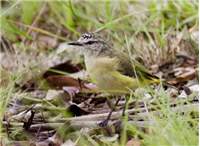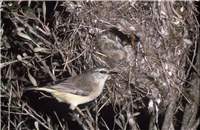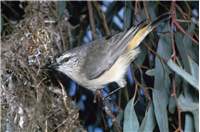Family
Pardalotidae
Genus
Acanthiza
Species
chrysorrhoa
Threats/Control Methods - Regional
The confidence of the Yellow-rumped Thornbill leaves it vulnerable to attacks from Cats (Felis catus) and Dogs (Canis familiaris). It is also hit on the road fairly regularly and is displaced by land clearing, urban developments, agriculture and grazing.
Threats/Control Methods - Local
Roadwork and highway extensions across Canberra may lead to an increase in road deaths for the species and a more fragmented habitat.
Local/Urban Actions
Cat owners can prevent their pets preying on the species by creating a stimulating indoor environment and by installing a cat run or enclosure. Dogs should be kept on a lead when walking through nature reserve areas. Using public transport or riding a bike when possible will reduce the chances of road kill.
Common Names
Yellow-rumped Thornbill, Yellow-tailed Thornbill, Yellow Tail, Chigaree, Tomtit
Distinguishing Features
The Yellow-rumped Thornbill is a small and stocky bird, however it is the largest of all the thornbills, reaching 12cm in size. Its bright butter-yellow rump, especially obvious as it takes off into flight, distinguishes it from other small birds. Its back and feathers are olive-grey and its forehead is black with clear white spots. It has cream-coloured underparts. Young birds are softer and fluffier.
Survey Techniques
Call and visual identification.
Species Call
A repeated, cheery chittering song of 3-4 seconds, ending with two clear whistles.
Similar Species
The Buff-rumped Thornbill (Acanthiza reguloides ) is very similar in size and appearance, lacking the bright yellow rump and the white spotted head.
Distribution
This species is widespread and found across all of southern Australia, the southern half of NT and most of QLD.
Country of Origin
Australia
Conservation (Pet/Pest) Status - Regional
Overall, population numbers appear fairly stable and it is considered the second most common woodland bird in the region (COG).
Conservation (Pet/Pest) Status - National
Secure, not listed under the EPBC Act 1999. Rapidly declining from areas of intense land clearing, especially in WA.
LSCCES Population
Highest numbers were found in Civic West, with others spotted at BMP, NMA, Turner and ANU.
Associated vegetation community
The Yellow-rumped Thornbill is found on the ground in open habitat, such as woodland, forest and in grassland. It is also common in agricultural lands and in parks and gardens, as it has adapted well to mown lawns.
Limiting Resources
Yellow-rumped Thornbills survive best in an area with ground cover, shrubs and logs. This species is prone to attacks from ground dwelling predators such as Cats (Felis catus) and Dogs (Canis familiaris) and requires an environment free from these predators. Ideally, appropriate nesting vegetation should be far from busy roads, as this species is also prone to being hit by cars.
Breeding
The Yellow-rumped Thornbill builds a large, messy and fairly noticeable nest of grass and spider web, generally in low hanging tree branches or vines. The nest is unusual, as it includes and false, open cup nest on top of the real chamber beneath. The male and female cooperate in breeding activities, sometimes including some other birds to help. 3 or 4 creamy, lightly specked eggs are laid and need 17 days of incubation. The young spend about 19 days in the nest and during this time are noticeable by their constant soft buzzing sounds. Nest activities in the Canberra region last from August to January.
Behaviour
This is the most obvious of all the thornbills to spot, due to its confident nature as it feeds on the ground and is constantly twittering and flashing its yellow rump. It can often be seen feeding in groups with other thornbills, such as the Brown Thornbill (Acanthiza pusilla ) or the Buff-rumped Thornbill (Acanthiza reguloides ), and birds such as Speckled Warblers (Chthonicola sagittata) and Weebills (Smicrornis brevirostris ).
Functional Group
Food Species
This thornbill feeds mostly on the ground for insects such as earthworms (Lumbricus terrestris). They will also eat some seeds.
Predators
Cats (Felis catus) and Dogs (Canis familiaris) are known to hunt and kill this species.
Interesting Fact
There has been no conclusion as to why the Yellow-rumped Thornbill builds a large, double-storeyed nest with a 'false' nest on top. Theries include its use as a predator deterant or as a practise nest for young birds to build.
References - (reader suitability of references, P=Primary teachers, S=Secondary students, T=Tertiary students and researchers)
Books:Freudenberger, D. 2001. Bush for the birds: Biodiversity enhancement guidelines for the Saltshaker Project, Boorowa, NSW. Consultancy report to Greening Australia ACT and SE NSW Inc. CSIRO Sustainable Ecosystems. Canberra. S, T
Morcombe, M. 2000. Field Guide to Australian Birds. Steve Parish Publishing. Archerfield. Australia P, S, T
Taws, N. et al. 2001. Bringing Birds Back: A Glovebox Guide for Bird Identification and Habitat Restoration in ACT and SE NSW. Greening Australia ACT and SE NSW Inc. P, S, T
Veerman, P. 2003. Canberra Birds: A report on the first 21 years of the garden bird survey. Philip Veerman and Canberra Ornithologists Group. Canberra. S, T
Internet: Birds in Backyards. 2006. [online]. Available at:http://www.birdsinbackyards.net P, S, T
Canberra Ornithological Group (COG). 2004. Birds of Canberra Gardens. COG and the ACT Department of Urban Services. [online]. Available at:http://garden.canberrabirds.org.au/ P, S, T
Online Publications:Nix, H. and Cunningham, R. 2006. Birds of the Lower Sullivans Creek Catchment, Canberra ACT. Prepared for the Life in the Suburbs project using data from the Lower Sullivans Creek Catchment Ecological Survey (LSCCES). Australian National University. Canberra. [online]. Available at: http://www.lifeinthesuburbs.com.au/category.php?id=65 S, T
Olsen, P. et al. 2005. The State of Australia's Birds 2006: Invasive Species. Supplement to Wingspan 16:4. Birds Australia. [online]. Available at: http://www.birdsaustralia.com.au/soab/SOAB2006.pdf S, T



 Top
Top Top
Top